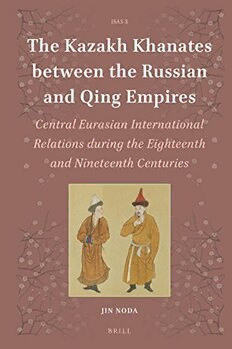
The Kazakh Khanates Between the Russian and Qing Empires: Central Eurasian International Relations During the Eighteenth and Nineteenth Centuries PDF
Preview The Kazakh Khanates Between the Russian and Qing Empires: Central Eurasian International Relations During the Eighteenth and Nineteenth Centuries
i TheKazakhKhanatesbetweentheRussianandQingEmpires © KoninklijkeBrillNV,Leiden,2016 | doi10.1163/9789004314474_001 ii Islamic Area Studies Series Editor ToruMiura(Ochanomizu University) Advisory board Abdul-KarimRafeq(College of William and Mary) NellyHanna(American University in Cairo) StephenR.Humphreys(University of California, Santa Barbara) DaleF.Eickelman(Dartmouth College) FaribaAdelkhah(Sciences Po-CERI) KeikoSakurai(Waseda University) VOLUME3 Thetitlespublishedinthisseriesarelistedat brill.com/isas iii The Kazakh Khanates between the Russian and Qing Empires Central Eurasian International Relations during the Eighteenth and Nineteenth Centuries By JinNoda LEIDEN|BOSTON iv Coverillustration:“Hasaketoumu”(Kazakhelder)fromHuangqing zhigong tubyXiesuioftheQing Dynasty:TheCollectionoftheNationalPalaceMuseum,Taipei,Taiwan,ROC. LibraryofCongressCataloging-in-PublicationData Names:Noda,Jin. Title:TheKazakhkhanatesbetweentheRussianandQingempires:central Eurasianinternationalrelationsduringtheeighteenthandnineteenth centuries/byJinNoda. Description:Leiden;Boston:Brill,2016.|Series:Islamicareastudies, ISSN2214-6555;volume3|Includesbibliographicalreferencesandindex. Identifiers:LCCN2016008886(print)|LCCN2016011593(ebook)|ISBN 9789004314443(hardback:acid-freepaper)|ISBN9789004314474(e-book)| ISBN9789004314474(E-book) Subjects:LCSH:Kazakhstan--Foreignrelations--Russia.|Russia--Foreign relations--Kazakhstan.|Kazakhstan--Foreignrelations--China.| China--Foreignrelations--Kazakhstan.|Russia--Foreignrelations--China. |China--Foreignrelations--Russia.|Sultans--Kazakhstan--History.| Nomads--Kazakhstan--History.|Nomads--Asia,Central--History.|Asia, Central--Politicsandgovernment. Classification:LCCDK908.75.R8N632016(print)|LCCDK908.75.R8(ebook)| DDC327.584504709/033--dc23 LCrecordavailableathttp://lccn.loc.gov/2016008886 WantorneedOpenAccess?BrillOpenoffersyouthechoicetomakeyourresearchfreelyaccessible onlineinexchangeforapublicationcharge.Reviewyourvariousoptionsonbrill.com/brill-open. TypefacefortheLatin,Greek,andCyrillicscripts:“Brill”.Seeanddownload:brill.com/brill-typeface. issn2214-6555 isbn978-90-04-31444-3(hardback) isbn978-90-04-31447-4(e-book) Copyright2016byKoninklijkeBrillnv,Leiden,TheNetherlands. KoninklijkeBrillNVincorporatestheimprintsBrill,BrillHes&DeGraaf,BrillNijhoff,BrillRodopiand HoteiPublishing. Allrightsreserved.Nopartofthispublicationmaybereproduced,translated,storedinaretrievalsystem, or transmittedinanyformorbyanymeans,electronic,mechanical,photocopying,recordingorotherwise, withoutpriorwrittenpermissionfromthepublisher. AuthorizationtophotocopyitemsforinternalorpersonaluseisgrantedbyKoninklijkeBrillnvprovided thattheappropriatefeesarepaiddirectlytoTheCopyrightClearanceCenter,222RosewoodDrive, Suite 910,Danvers,ma01923,usa.Feesaresubjecttochange. Thisbookisprintedonacid-freepaperandproducedinasustainablemanner. ContentCsontents v Contents Acknowledgements ix Notes on Transliteration and Sources xi List of Figures, Maps and Tables xii List of Abbreviations xiv List of Chinese Characters xvxx Introduction: The Kazakh Khanates’ Place within the Central Eurasian World 1 1 TheHistoryoftheKazakhSteppeandtheKazakhKhanates 1 2 ThemestobeAddressed 4 3 MethodologyandSignificance 9 4 OutlineofContent 12 5 DescriptionofHistoricalSources 14 Part 1 The ‘Kazakh Khanates’ and the History of the International Relations in Central Asia 1 Reexamining the Kazakh Khanates’ “Foreign Relations in the East” 23 Introduction 23 1 AHistoryofResearchRegardingtheKazakhKhanates 23 2 AHistoryofResearchRegardingtheKazakh-QingConnection 25 3 HistoricalRelationsbetweentheKazakhSteppeandXinjiang 41 Conclusion 53 2 The Impact of Russian Advances into Central Asia on Kazakh-Russian Relations 54 Introduction 54 1 ThePetitionforRussianSubjectStatusandanOathontheQuran 54 2 TheKazakhTitleof“Khan” 66 3 Establishmentofthe1822RegulationwithintheMiddleJuz 80 Conclusion 96 vi Contents Part 2 The Foundations of Kazakh-Qing Relations 3 The Problem of Kazakh Subjection and the Russian-Qing Relationship in Central Asia 101 Introduction 101 1 TheJungarsandCentralAsiawithinRussian-QingRelations 103 2 TheTošiMission’sProposals(1731)andRussia-QingNegotiations 112 3 TheRussian-QingNegotiationsof1756–1758RegardingCentral Asia 120 Conclusion 140 4 The Differing Nature of the Three Kazakh Juz and the Three “Bu” (Sections) Mentioned in Qing Historical Sources 144 Introduction 144 1 EighteenthandNineteenthCenturyKazakhSocialStructureas DescribedwithinQingHistoricalSources 145 2 TheMeaningoftheTerm“Hasake”withinQingHistoricalRecords153 3 RelationsbetweenthethreeKazakhJuzandtheQingEmpire 167 4 TheThreeSectionsintheViewoftheKazakhs 175 Conclusion 179 5 Titles of Kazakh Sultans Bestowed by the Qing Empire: The 1824 Case of Sultan Ghubaidulla 181 Introduction 181 1 QingTitlesfortheKazakhs 183 2 SultanGhubaidullaandHis HanTitle 191 3 TitlesforKazakhsThereafter 204 Conclusion 211 Part 3 Russo-Qing Relations and the Fate of the Kazakh Khanates 6 Kazakh Participation in the Russo-Chinese Trade of Central Asia 215 Introduction 215 1 TheKyakhtaTradeandRusso-QingTradeThroughoutWestern Siberia 216 2 RussianandQingTradingPolicies 220 3 IntermediaryRoleoftheKazakhsinRusso-QingTrade 233 4 ChangesintheStructureofTrade 248 Contents vii 7 The Transformation of the Russian-Qing Relationship and the Dissolution of the Kazakh Khanates 260 Introduction 260 1 FrontierRulebytheTwoEmpires:TheWesternSiberianGovernor- GeneralandtheIliMilitaryGovernor 260 2 TheRoleoftheKazakhSteppewithinRussian-QingRelations 272 3 TheSultansinTransition 287 4 FrictionRegardingtheAnnexationoftheGreatJuzandEstablishment ofthe1851TreatyofCommercebetweenRussiaandtheQing Dynasty 293 Conclusion 302 Conclusion 304 Bibliography 313 Index 342 350 113111323314311∵112∵2312∵231245p22231122233112322222322233234CCCAANNLLLLLLIT34TCR23CT1pTCT1233CT34CT12333pRCK222344CT2344CCBBIIa21n............nn.......................................n.....iiiiii331132224112aaahhhhhhihiieuooohhhhhhhooaccoo21211131222321231111312321234534212123222131sssssstbbddt. rrrdekkzeeeeeees.. nnnnnlaaaaaaatttttttttttllreeeeexsannpppppppiitttccooooooTtK‘IFPDxxoso123oossKaeeekhmoolltttttttfffffforruu-aggmnnniodeeeeeeehooaawweoQfFFAACCurrzpssrrrrrrrftttfnnzunbaaiPiiiienQasssllhhbbia1234567aKnggooeescppnlrakTTdiicbbekiuufddinniatnnhhgrnhorrntnamrrhrrtggzaaiyyeeeergteeogRigoKmmannmicssKvvssfooeDknteeNihss,,iiheehplRnfaaahllMMyaaCCaiinnaaetttsKuttntntSiiinhhtteetiaaouoosoKaassiauorraaaspponnnrzfstaaanlitrressenttaassttKezaasoyasiiknaaosaccooianf’ah’nnnfkttPznnAntsaeeddhtahSltnrrddBhaaahkuessTTKdvnnceehetbaaRaehhsddTt-bbjRtnuhQeaewohSSllucncseeewFiooriesstnssateaHuuiissehtgoaetorrediiiennccsRn-nKsCt-eebo’teaoaQtss“oyfhlnhzFraitiytCadnoetnhhkiregoeCoeteehnhfsnReiKQetgetJnserhuaniTalRtnzezarrlRuagataIAaiekslndonEsslhEetnaiidmeaautKsornitrphonofhha-iinnaQCsearpetisneKaiTia:noiannhTanngnttzrhdeWrateRaasehltekoelheR1hlAr“8eaeBlE-2dstRlDuaii4aaous”tiCtnsis(”ossaSsoinhsealseicnuptiotniRiiofoneCnSnlCsuae)otnletifMntoarttnnaherslaneGAlt‘hiKAsouiasnabizeaaadikdihunKlQlahianng1II12I22I9IC2TC5IC1ITCCvviixxxxFMTxxxx1TTMOD222AAIRCHTQL5TTTSRT“RDETT991TTTSTTRTTTTC1ETRAAWRTTT1QTRTSTDGRTGT222TRRRQIDKTCTTRC2FRTGLTCTF2TT3333UPPS33axx80048nnnnnnnmnKH33001144441111111169uuueiiiiiivvea999rrooirtrrsihhhhhhhhhhhhhhhhhhhhhhhhhhihhhhhhhhheeeeeeouuuuuuooooohohohanphhoneeeeuuiiiiivv3333355g11141gteoaeHHiettttttttiih44tc223zhb0nnsbslccisiavlluzeeeeeeeeeeeeeeeeeeeeeeeeeeeeeeeeeesssssscnnnnnnnepsvtlaiaammveprrrrrrrauuptruathaasgstpntnoepeenaaaalssssssaipggcjoooooooaliimtbae ltennhrolcccccecct’ebeTTTTWTTbbttneuHPORK1JBRJAKMGSRr‘RKPRCERSreEitssksiiiiiisiadnityeteillnLreaaomkpdddddddnleuun8riāellllllleeaaaaaarnoTrggoaPittlsowiamulcrrreaabhioisereeeouoyisuuuuuuuenorsaaNslndsrrrIfassia”irheiooiodS2’’rcnuuuuuuulspoennnnnnaeeeeesertnvcodgttissštsoiiaiaslsecayygllseGepllmsrilzznsnsssssssatssraCtma2aaoeuddeirrsatfonaeaaiaanassiarccccccceictāthoshggpelol aahIriskRdoiiiiiiiWloiaaGtt‘MasIPaPmyyisootRrdfiniimSSphbRaflnRgttttnuultttttttoooooooagfenAoroMaatosi’seifRiiodRlmtoosculhoohkklyonetiKfnnuiiTyyeooiiiiiiiaohoorīnnfloiooocbefTtlilasuootennnnnnnrranllninutftooeaoooooooRyefEeḫebīnnenJfJhhsnuieonyotf (SrlliCnnsrdlshfssehniauueLbgt’lSagtfesooerrsuffutbsnaaofainnliesnnnnnnnnnMAaasagtQseKedl-xssetgnrsistigtahoiryeneoczag-heTolioyoitoerrnoetTaaah’ffiApazszaRRndhoQnnoanumbehnsssstflesinStQmcATelnwccgoiaohariHregaoimfiufnnSonsfaasḪtteiiiRhhteboK1teSleafGe-nAeectultbodeddoraaeeDritkdaroSXfidftoa8 oshftiaoaTnftatQrrretttiddStHceomNnsynnfZiitfssooalcytitnnugnbtssuaSniiseeondhhihKhhhfeacnuppK5fr“ettqnitNioeunerohteeetonddeRftdRhagtldnuimntnSyehoirirntgdli’dCAenniitdiah1eoSsuePeeatleusnQanahdaacrrfoasgknroeDigokhnncviiNbbtJeuuleusgoMhmgsPjTentiacslrtfaneeuSotbtnmuaNTzrruahzgttPehKsnietTenaKKhosbfleiooeesrRetoHbSbhtoeocceRtarrahhloCOnsihaalntttcaaeimGdnhesseohTrsiaheJfastttieg“aoaptiTsRbaamnrhhRihuiushcjenenTatooskfe-teeouokitteiicQawwKghiitoeoegištsgnienrRehdzrteyzztd1suueaseesrenaree erwrugilfdhchyhXnpieTziheeMatRRc8aroianšQQaaiIahoaaierdasei-ieeientneeulatTrmn‘naAhdesoDsdPnnfeientcaro2TSmaBnliawoaetkldieetkakeRŠnKneenagnSUniisllilinhotaoeeEieHenrtrM2tontSrncgcsSgnwwnlAnggnhidrtaiehhnnuaniatvduKetiJaESmoiaforsn-jrdsrnaahciaiuetvGJlaaon“VduhrnaogrtiiogRtsg Lr”CfcPsegodeeiizsoatiuafmYplaHSShstKaneqnsIpdiirerrIbatinsirenzstsythtihonaea,eoheonetuotWonono“ddChzzTutanroeoiīh-sRsncHipoajbxassuMtsDepkgWvatc(tlnnneQgfearouuimgiicrKlwsgeateeizeekaee-wC1eRospeuennsctnhttEaiaEucckhtasgifterQb7snraSriaaghteaaeht”tdaersnnhploKudggBitstwtfnilhara3voeeihwtCoukmannninetzttsasftsekinCsaoea’nheeseolS1geossugsahenfhtttteTfhia saK’scoetMie)nsndaS:SoethhetEilncaeczra)rhetgRaPkiiDh1”irRioohreaT1nedaartoTnnsemyhltateea7nssa-nIooh8KrulwnunptnTQesliinzcChdrtuerGl5kveoedunp3KnfdKKaRRiJasnlpi,marat6roJdeharieiuRSawpb0esstnlaiMKtgbuatsanuukzcaaaiMR–ntonnohetihzhsnuWonudeoRndSazalheizhzzrassgaii1mucsntiteienoinsteesgelatConsska7aaudnsezluhntaRieetsaSesSisoidrnkt5htnkkahdDiadGashe-Tttasrniisayl pKoJeto-8thQQhs anasohhmksycdeisntaenethaeslQordgapanihearosyeNfrh-peptaRtiianc-SartKnntyQe”ehrnQziennirttQaasho-alhnpapoKtrendnhanha-im(hQiGggthiOdniueKtngeQepdciXSglnkaenteiaIinSJeiiaegioHRneyaoAatzhMnGgaiuingoTanotiQgQrhssnbvstebazQnhnilosgzfdrfga‘eohtKCesoitalugRRkiieiaeaSedfdtiaiRBhntnvaratNukohhnrnde)eeloomtRhnttdeQenguegi?XrhtnsalsiBeghegnrareeKolauossduiiWsniCWgEennoenotlVncCstnrnctthHlaooaimeorEimfhaatJtRgijeeoesGatadtwtusceiuiulnsAeihssienaonnsnpeDetowotzaRrtrtitsinidlatQsnairen’etntvpooDeyerrsbgimtortegaaesrunnoaceoniwlyrflonsosrinaTsinfstnaA“fi’dSorssDihrtSton‘dttiiNfhsiEhsubtylmrecsiehEtia-aeabetsnrGsessedacrajKtneirsCeiteBariatcitnbereveztSnoenere”sahrn’ftdtkDaaoRrthKlawhwheislasaleiatanAtzrl1htdais8iocioik5naftthnhs1.QQssTetirianInelngiagMtTHyiitiolsliefttoasCrroyicmG122461468122252111111112222211223445566678911111111111112222222xxx492356911111111111222222222222222333331a77799933988601244240011555568012468853873373232227201112844436614164506899500014455588iii2110404706069lm0252o953iii70333334950661333335116116448067769227233600148244779185089480001SiveoerurcnrecoebrsetweenRussia 214650 viii Contents AcknowAlcekdgnmowenltesdgments ix Acknowledgments ThepreviouseditionofthisbookwaspublishedinJapanesebytheUniversity ofTokyoPressin2011.Ithasbeencompletelyrevisedandmuchsupplementa- tionhasbeenaddedtotheJapaneseedition. WhilewritingmyPhDdissertation,whichformsthecoreofthisbook,my researchdependedontheassistanceofnumerousindividuals,manyofwhom areinKazakhstanwhereIhadstayedfortwoyears(2002–2004,attheInstitute ofOrientalStudies)toconductresearchmainlyattheCentralStateArchivein Almaty.Ishouldliketothankthefollowinginparticularfortheirkindhelpin thosedays:MeruertAbuseitova,NagimaSagandykova,KlaraKhafizova,Niko- laiKropivnistskii,andMarziyaZhilisbaeva. Intheyearsfollowingmydoctoralwork,Ihavebeenabletoattendseveral annualCESS(CentralEurasianStudiesSociety)meetings.Attheseevents,Ies- peciallyenjoyedtheopportunitytohavediscussionswithresearchersfrom aroundtheworld.Amongthese,IwouldespeciallyliketothankAllenFrank andVirginiaMartinfortheirkindandsincerecommentsonmyresearch. Needlesstosay,myresearchhasbeenheavilyinfluencedbyJapaneseschol- ars.Firstofall,Ioffersinceregratitudetomyadviser,HisaoKomatsu.Iwould alsoberemisstoomitthenameofthelateToruSaguchi,oneofthefounders ofXinjiangstudiesinJapan.Iwouldalsoliketoexpressmygratitudetothe membersofmydoctoralcommittee:TomohikoUyama,YasushiShinmen, Sei’ichiroYoshizawa,NorieIshii,andHisaoKomatsu. RegardingtherevisionoftheJapaneseversion,commentsbybookreview- ershavebeenveryhelpful.Igreatlyappreciatethecommentsandcriticismof: TakahiroOnuma,TomomiNakamura,KazumasaHayamaru,KiyohikoSugiya- ma,AkiraYanagisawa,andKoichiShibuya.IalsothankBretFiskforhishelpin editingmyEnglishtexts.IthankHideyukiNaganumaforhisassistanceaswell. ThisbookisapartoftheIslamicAreaStudiesprojectinJapan.Iexpressmy sinceregratitudetothetwolateex-generaldirectors:TsugitakaSatoand TakeshiYukawa,aswellasthepresentdirector,KeikoSakurai.Ialsoappreciate thehelpofToruMiura,chiefeditoroftheISASseries. Lastly,Ishouldliketothankmyfinancialsupporters:JSPSKAKENHI(Grant Number15K02914),NIHUIslamicAreaStudiesproject(FY2014),JFE21stCen- turyFoundation(2014:AsianHistoryResearchAidProjects),WasedaUniver- sity’ssupportforacademicpublications(FY2015),andthePublicationsFund ofWasedaUniversity(FY2015).Regardingthelasttwoitemslistedabove,the x Acknowledgments officeoftheWasedaInstituteforAdvancedStudy,whereIamcurrentlyem- ployed,hasbeenofgreatassistance. Finally,Iwouldliketothankmywife,MikiWatanabe,andmytwodaughters –AkariandMarika–fortheirloveandsupportofmyresearchactivities. Jin Noda WasedaInstituteforAdvancedStudy,Tokyo November2015
